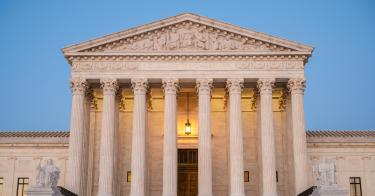On Monday, the U.S. Supreme Court announced that it would take up a Wisconsin redistricting case. Its decision in Gill v. Whitford will determine whether the Court intrudes into the realm of partisan gerrymandering, a “political thicket” into which previous justices have feared to tread.
In Gill v. Whitford, a split three-judge federal panel invalidated Wisconsin’s redistricting plan for its state legislature. The two-judge majority claimed that it was an unconstitutional gerrymander, because the Republican-controlled legislature had drawn districts favoring the Republican Party.
The panel came to this conclusion despite the fact—undisputed in the case—that the legislature had followed all the redistricting criteria traditionally used by states. For example, the plan ensured that districts consisted of contiguous territory, were as compact as possible, and respected political subdivisions like counties and cities.
Over 70 years ago, Justice Felix Frankfurter warned the Supreme Court against getting into the “political thicket” of redistricting.
In Colegrove v. Green, he said that the court should not get into the business of drawing political maps. But starting in the early 1960s, the Supreme Court ignored that warning. It has since handed down a series of decisions regarding redistricting. Unfortunately, the rules established in these decisions are very confusing, which is why there are more redistricting cases before the Supreme Court almost every term.
Generally speaking, the court has decreed that when states redraw their congressional boundaries, they must create districts with as equal a population as possible, in order to avoid violating the “one person, one vote” standard of the Equal Protection Clause of the 14th Amendment. The Court gives states a little more leeway with state legislative districts in order to allow the states to comply with traditional redistricting requirements.
Under the Voting Rights Act, states are also in trouble if race is the predominant factor in their redistricting. But they are allowed to use some race in redistricting to comply with the VRA and protect minority voting rights. How much race they can use is unclear – it has to be “just right,” which is why I call it the Goldilocks Rule of Redistricting.
Until now, however, the Supreme Court has stayed out of political gerrymandering as opposed to claims over racial gerrymandering or unequal populations in districts.
The holding in the Wisconsin case violates prior precedent of the Supreme Court. In 2004, in Vieth v. Jubelierer, which involved a similar claim by Pennsylvania Democrats against the Republican-controlled legislature, the Supreme Court tossed out their lawsuit. Four justices held that political gerrymandering claims are not “justiciable,” meaning they are not claims that courts should consider.
Justice Anthony Kennedy agreed that the Pennsylvania claim should be thrown out, although he left open the possibility that the Court might consider a political gerrymandering claim if some kind of legal standard could be established for what type of behavior was unconstitutional. But that is virtually an impossible task.
Drawing up political districts is, by its very nature, a political exercise by the legislative branch. How could one possibly determine how much or how little politics is acceptable in the redistricting process? The Constitution says nothing about this at all, other than to give state legislatures the authority to draw not only their own state legislative districts, but congressional districts as well.
In the Gill case, two federal judges bought the arguments of two law professors (not professional mathematicians, statisticians, or political geographers), who claim to have come up with a standard that has eluded the courts – a judicially manageable standard to determine when a political gerrymander is unconstitutional.
They call their standard the “Efficiency Gap,” because it considers any vote “wasted” if not “properly distributed.” They define every vote for a losing candidate as “wasted,” as well as every vote not needed to secure a victory. So if there are only two candidates in a race, all of the votes above 50 percent for the winning candidate are “wasted.”
This dubious theory has so many problems, it is hard to understand how a federal court could possibly give it any credence. It ignores the reality of political geography that some voters who support particular political parties are naturally “packed” as a result of residential patterns, not because of choices made by legislatures.
Democratic voters tend to congregate in urban areas, while Republicans tend to congregate in suburban areas. Trying to draw districts that ignore these residential patterns to meet the “Efficiency Gap” test would result in even more bizarrely drawn districts than we already get from legislators, and would make it much more difficult to draw districts that are compact, contiguous, and don’t cross political lines.
As the dissenting judge said, it is also hard to understand how anyone could believe that a purported “proof of intent to act for political purposes” in redistricting, a task that has been “constitutionally entrusted to the political branches of government, is unconstitutional.”
Moreover, the “Efficiency Gap” is based on comparing the number of seats in a legislature with the number of statewide votes that different parties get. But the Constitution does not require proportional representation of the political parties (indeed, it does not refer to parties at all). Such a concept should be soundly rejected by the courts.
In Cooper v. Harris, a North Carolina redistricting case that the Supreme Court decided on May 22, dissenting Justice Samuel Alito echoed Justice Frankfurter when he warned the Court against transforming the federal courts “into weapons of political warfare.” Otherwise, they will “invite the losers in the redistricting process to seek to obtain in court what they could not achieve in the political arena.”
That is exactly what is going on this case. The Supreme Court should heed Justice Alito’s advice.
This piece originally appeared in Fox News




